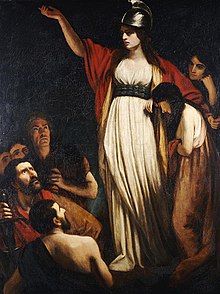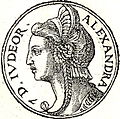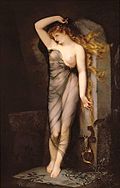List of 999 women of the Heritage Floor / Boudicca
This list describes the place setting for Boudicca on the table of Judy Chicago's art installation The Dinner Party . It is part of the list of 999 women on the Heritage Floor who are assigned to the respective place settings on the table. The names of the 999 women are on the tiles of the Heritage Floor, which is arranged below the table and belongs to the art installation.
description
The installation consists of a three-sided table, each with 13 historical or mythological personalities, thus a total of 39 people, from prehistory to the women's rights movement . These people were assigned a place setting at the table, consisting of an individually designed table runner, an individually designed plate, a goblet, knife, fork, spoon and serviette. The first page of the table is devoted to prehistory up to the Roman Empire , the second to Christianization up to the Reformation and the third from the American Revolution to the women's movement. Each place setting on the table is assigned additional personalities who have received an entry on the tiles of the Heritage Floor, which occupies the space under the table and the center of the space between the sides of the table. This list includes the personalities who are assigned to the Boudicca table setting. Your seat is on the first side of the table.
Hints
In addition to the names as they are used in German transcription or in scientific usage, the list shows the spelling chosen by Judy Chicago on the tiles.
The information on women who do not yet have an article in the German-language Wikipedia is referenced by the individual references listed under comments . If individual information in the table is not referenced via the main article, additional individual references are given at the relevant point. If there are any discrepancies between the information provided in Wikipedia articles and the descriptions of the work of art on the Brooklyn Museum website , this will also be indicated under Comments.
Place setting for Boudicca

Boudicca was queen of the Iceni , a Celtic tribe. After the death of her husband, King Prasutagus , Boudicca was not accepted as queen by the Roman government. The Roman occupation policy led to increasing problems and Boudicca was publicly flogged, and her virgin daughters were raped. This outrage led to the Boudicca uprising in AD 60, when Boudicca and her army, which probably comprised more than 50,000 fighters, moved south and attacked and plundered Roman settlements. Today's Colchester was burned to the ground, killing all of its residents. So did London and St Albans .
Although it was able to gather a large army around it and the initial successes brought more fighters into its ranks, it did not have enough to oppose the sophisticated warfare of the Romans. The Roman general and governor of Britain, Gaius Suetonius Paulinus , opposed her with two legions in a battle in the open field and defeated the British, who had previously only carried out guerrilla-like attacks.
There are two versions of the further fate of Boudicca: Tacitus reports that Boudicca took his own life through poison ( Annalen 14.37.3), Cassius Dio, however, thinks that Boudicca fell ill and finally died (62.12.6) .
Her place settings on the dinner table were designed in powerful images inspired by Celtic mythology to portray her as a warrior queen. For the design on the runner, felt was used, which was probably already used before the first woven textiles. According to Chicago, the powerful, curvilinear shapes that surround the plate represent both the personal strength of Boudicca and the encroachment of the Romans on their autonomy and power.
The plate itself is designed with a stone formation similar to the formations in Stonehenge , said to represent the British Isles from which Boudicca's people came. A stylized golden helmet, which is also decorated with Celtic patterns, shows Boudicca's status as a warrior. Handcrafted enameled jewels adorn the swirling patterns of the table runner. They should be reminiscent of the traditional Celtic jewelry, as well as the decoration of the initial letter "B".
| Surname | Spelling on the tile | Date of birth | cultural spatial assignment | Remarks | image |
|---|---|---|---|---|---|
| Aretaphila of Cyrene | Aretaphilia of Cyrene | about 50 BC Chr. | Ancient Greece , Cyrene | Noblewoman from Cyrene who is said to have opposed the tyrant Nicocrates . | |
| Arsinoë II. | Arsinoe II | around 315 BC Chr. | Ancient Greece | Queen of Thrace , Macedonia and later co-regent of her brother and third husband of Egypt. She shared all of her brother's titles and won chariot races in the Olympics. Her image was featured on coins and she established her own cult. |

|
| Artemisia I. | Artemisia I | 5th century BC Chr. | Ancient Greece | The Queen of Halicarnassus fought against the Greeks for Xerxes I during the second Persian invasion of Greece. |

|
| Artemisia II. | Artemisia II | 4th century BC Chr. | Ancient Greece | Sister and wife of the famous King Mausolus , she created the mausoleum as one of the seven wonders of the ancient world in memory of her husband. |

|
| Basileia | Basilea | N / A | Ancient Greece | Daughter of Uranus and Titaia, first queen of the Kingdom of Atlantis in ancient Greek folk tradition. | |
| Brünhild | Brynhild | N / A | Germanic culture | Figure from the Nordic saga. |

|
| Cartimandua | Cartismandua | 43 | Britain | Queen of the Brigands . They came to power around the time of the Roman conquest of Britain and formed a large tribal agglomeration that became loyal to Rome. |

|
| Chiomara | Chiomara | 2nd century | Galatia | Princess and wife of Ortiagon , a leader of the Tolistobogier tribe . |

|
| Eachtach | Eachtach | N / A | Irish mythology | In one version of a myth, Eachtach Fionn asked her dying father to help, but he refused. To avenge her father's death, Eachtach gathered her brothers into an army and fought Fionn for four years until he was tired of the constant fighting. In the end, however, Eachtach failed to kill Fionn. | |
| Cleopatra VII. | Cleopatra | 69 BC Chr. | Old Egypt | Last queen of the Egyptian Ptolemaic empire and at the same time last female pharaoh . |

|
| Kynane | Cynane | 3rd century BC Chr. | Macedonia | Princess from the house of the Argeads with a particularly warlike character. | |
| Macha Mongruadh | Macha of the Red Tresses | N / A | Irish mythology | Macha Mongruadh, daughter of Áed Rúad ( Dagda ), was, according to medieval legend / historical tradition, the only queen in the list of the High Kings of Ireland . | |
| Medb | Meave | N / A | Irish mythology | Figure of the Celtic mythology of Ireland , daughter of Eochaid Fedlech , sister of Mugain , Queen of Connacht , who lived in the royal seat of Cruachain (see also Echtrae Nerai ). |

|
| Medb | Medb of Connacht | N / A | Irish mythology | Figure of the Celtic mythology of Ireland , daughter of Eochaid Fedlech , sister of Mugain , Queen of Connacht , who lived in the royal seat of Cruachain (see also Echtrae Nerai ). | |
| Muirgel | Muirgel | N / A | Ireland | Irish woman who helped her country fight off a powerful enemy by killing one of her leaders in 882. | |
| Olympias of Epirus | Olympias | around 375 BC Chr. | Macedonia | Around 357 BC She married the Macedonian King Philip II and became the mother of Alexander the Great . |

|
| Salome Alexandra | Alexandra of Jerusalem | 140 BC Chr. (Uncertain) | Judaea | Queen of Judea , wife and successor of the Hasmonean king Alexander Jannäus . |

|
| Tomyris | Tomyris | 6th century BC Chr. | Massagers | As a widow the sole ruler of the massagers. The Persian king Cyrus II wanted to conquer her empire, first by offering her marriage, then by conquest, on which he was beaten and killed by her. |

|
| Veleda | Veleda | 1st century BC BC or 1st century | Germanic peoples | Germanic seer from the Brukterer tribe at the time of Vespasian . It is of historical importance through its participation in the Batavian revolt of Julius Civilis , in which it prophesied victory for the rebellious Teutons. |

|
| Zenobia | Zenobia | at 240 | Palmyra | Ruler of Palmyra and the Roman Orient. She was the second wife of the exarch of the oasis city of Palmyra, Septimius Odaenathus . Her Aramaic name was Bat-Zabbai. |

|
- Individual evidence
- ↑ Brooklyn Museum: Boadaceia. In: brooklynmuseum.org. Retrieved October 16, 2019 .
- ↑ Brooklyn Museum: Aretaphilia of Cyrene. In: brooklynmuseum.org. Retrieved October 17, 2019 .
- ↑ Patricia Monaghan: Encyclopedia of Goddesses and Heroines [2 volumes] . ABC-CLIO, 2009, ISBN 978-0-313-34990-4 , pp. 316 ( books.google.de ).
- ↑ Brooklyn Museum: Medb of Connacht. In: brooklynmuseum.org. Retrieved October 17, 2019 .
- ↑ James F. Cassidy: The women of the Gael . Stratford Company, Boston 1922, p. 76 .
Web links
- Brooklyn Museum, Boudicca
- The Dinner Party on the website of Through the Flower , Judy Chicago's non-profit organization